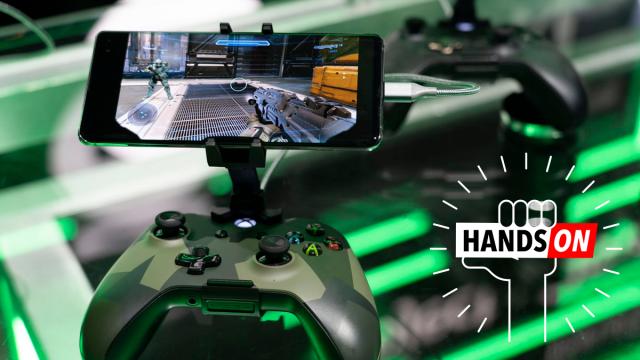While Google has already held two splashy events about Stadia, its big bet on streaming games, Microsoft, has been a little more lowkey about its own streaming game initiative, xCloud. We still don’t know a whole lot about it, but today I got to play it—and watch it break.
The concept behind xCloud isn’t a new one. The games run on a server in the cloud and stream a video to your device, only streaming is so seamless, that you never feel like the device playing the game is on the other side of the state. That’s not an easy thing to do.
Latency will kill a game. If you press the jump button, but the server doesn’t register that jump until a few moments later, you’re not going to be able to play the game very well.
Sony, Nvidia, and Shadow have been streaming games for a while—Sony turns your PS4 into the server and is reliant on your internet, while Nvidia and Shadow put it all through a remote server. xCloud, when it goes into public trials in October, will let you do both.
You’ll be able to play remotely from your own Xbox One, or you’ll be able to play using their servers. Microsoft told me the servers are Azure based (that’s Microsoft cloud computing platform), but the hardware is essentially an Xbox One.
So what do the games stream to from the server/Xbox? Microsoft hasn’t disclosed support for iOS or any browser, but I played both Halo and Hellblade on Samsung S10 Plus devices connected to Xbox One controllers. Microsoft told me that xCloud currently works on devices all the way back the Samsung Galaxy S7, but it could possibly run on older hardware as well. So Android, at the very least, is supported.
As with other streaming services, crummy bandwidth will kill the experience. Microsoft representatives wouldn’t tell me exactly how much bandwidth will be required, but it was clear that the middling convention centre internet at E3 wasn’t enough. While attempting to play a racing game, a window popped up telling me the game had been disconnected and would reconnect momentarily.
Moments earlier, a Microsoft rep had assured me the phones were all running on a dedicated wifi network to avoid issues. Big conventions are generally places with messy wifi. I counted 26 different full strength wifi signals broadcasting in the demo area, and that doesn’t include people tethering to their phones or unlisted wifi networks. It’s a lot of noise, and if there is too much noise, your wifi will struggle to connect, and your speeds will take a nose dive.
What happened to all the xCloud devices was someone in the demo area was operating on the same wifi channel and cluttering it with a lot of noise. Enough noise that the games would periodically disconnect. Other times the quality would degrade into a pixellated mess. Impressively, I didn’t die or notice a lack of responsiveness when the stream degraded (the total disconnects were another story).
Eventually, Microsoft had to hardwire each device into the internet to assure a more functional demo. Things were smooth then. Snappy gameplay. No missed shots. No ugly artefacts. Just smooth rounds of Xbox One-quality Halo on a phone.
But with xCloud so dependent on the internet, the demonstration also highlighted the most significant problem facing Microsoft, Google, and all their other competitors: The internet.
As long as the internet can mess up, for any of a number of reasons like lousy wifi and network congestion, cloud gaming will be a crapshoot. I might be able to play Halo on my phone come October, but I won’t actually be able to take Halo with me everywhere.
